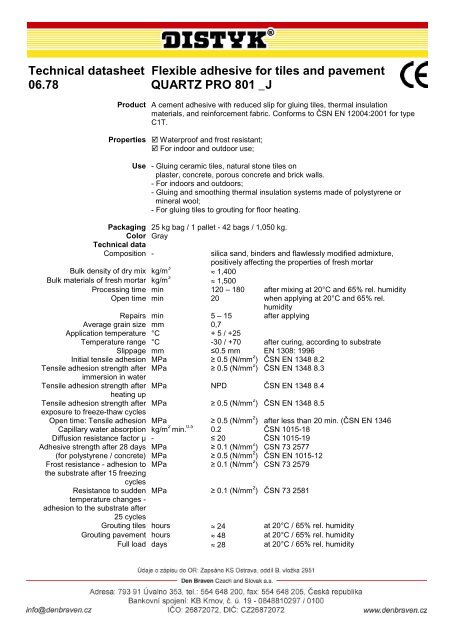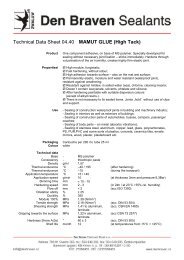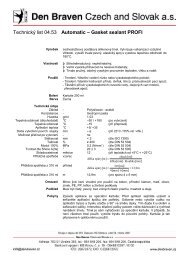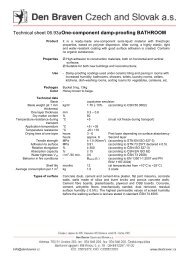Technical Data Sheet - Den Braven
Technical Data Sheet - Den Braven
Technical Data Sheet - Den Braven
Create successful ePaper yourself
Turn your PDF publications into a flip-book with our unique Google optimized e-Paper software.
<strong>Technical</strong> datasheet Flexible adhesive for tiles and pavement<br />
06.78 QUARTZ PRO 801 _J<br />
Product A cement adhesive with reduced slip for gluing tiles, thermal insulation<br />
materials, and reinforcement fabric. Conforms to ČSN EN 12004:2001 for type<br />
C1T.<br />
Properties Waterproof and frost resistant;<br />
For indoor and outdoor use;<br />
Use - Gluing ceramic tiles, natural stone tiles on<br />
plaster, concrete, porous concrete and brick walls.<br />
- For indoors and outdoors;<br />
- Gluing and smoothing thermal insulation systems made of polystyrene or<br />
mineral wool;<br />
- For gluing tiles to grouting for floor heating.<br />
Packaging 25 kg bag / 1 pallet - 42 bags / 1,050 kg.<br />
Color Gray<br />
<strong>Technical</strong> data<br />
Composition -<br />
silica sand, binders and flawlessly modified admixture,<br />
positively affecting the properties of fresh mortar<br />
Bulk density of dry mix kg/m 3 ≈ 1,400<br />
Bulk materials of fresh mortar kg/m 3 ≈ 1,500<br />
Processing time min 120 – 180 after mixing at 20°C and 65% rel. humidity<br />
Open time min 20 when applying at 20°C and 65% rel.<br />
humidity<br />
Repairs min 5 – 15 after applying<br />
Average grain size mm 0,7<br />
Application temperature °C + 5 / +25<br />
Temperature range °C -30 / +70 after curing, according to substrate<br />
Slippage mm ≤0.5 mm EN 1308: 1996<br />
Initial tensile adhesion MPa ≥ 0.5 (N/mm 2 ) ČSN EN 1348 8.2<br />
Tensile adhesion strength after MPa ≥ 0.5 (N/mm 2 ) ČSN EN 1348 8.3<br />
immersion in water<br />
Tensile adhesion strength after MPa NPD ČSN EN 1348 8.4<br />
heating up<br />
Tensile adhesion strength after MPa ≥ 0.5 (N/mm 2 ) ČSN EN 1348 8.5<br />
exposure to freeze-thaw cycles<br />
Open time: Tensile adhesion MPa ≥ 0.5 (N/mm 2 ) after less than 20 min. (ČSN EN 1346<br />
Capillary water absorption kg/m 2 min. 0.5 0.2 ČSN 1015-18<br />
Diffusion resistance factor μ - ≤ 20 ČSN 1015-19<br />
Adhesive strength after 28 days<br />
(for polystyrene / concrete)<br />
Frost resistance - adhesion to<br />
the substrate after 15 freezing<br />
cycles<br />
Resistance to sudden<br />
temperature changes -<br />
adhesion to the substrate after<br />
25 cycles<br />
MPa<br />
MPa<br />
≥ 0.1 (N/mm 2 )<br />
≥ 0.5 (N/mm 2 )<br />
CSN 73 2577<br />
ČSN EN 1015-12<br />
MPa ≥ 0.1 (N/mm 2 ) CSN 73 2579<br />
MPa ≥ 0.1 (N/mm 2 ) ČSN 73 2581<br />
Grouting tiles hours ≈ 24 at 20°C / 65% rel. humidity<br />
Grouting pavement hours ≈ 48 at 20°C / 65% rel. humidity<br />
Full load days ≈ 28 at 20°C / 65% rel. humidity
<strong>Technical</strong> datasheet Flexible adhesive for tiles and pavement<br />
06.78 QUARTZ PRO 801 _J<br />
Consumption of water liters ≈ 6.0 – 7.0 25 kg of adhesive<br />
Consumption of adhesive kg/m 2 1.6 – 2.4 gluing a mosaic<br />
kg/m 2 2.4 – 3.4 tile adhesive<br />
kg/m 2 3.6 – 4.5 gluing coarse ceramic<br />
kg/m 2 ≈ 3.0 gluing 3 mm thick insulation material.<br />
kg/m 2 ≈ 4.0 smoothing reinforcing grid<br />
Limitations Do not use when temperatures are below +5°C (air and surface) and frost is<br />
expected. It is not suitable for gluing in direct sunlight – protect from rapid<br />
drying. Not suitable for metal, plastic materials and wood-based materials. Not<br />
suitable for sticking tiles to heated floors with rapid increases in temperature<br />
(electric matting). Do not use on lime plaster, paint coatings, wood and old<br />
tiles.<br />
It cannot be used for gluing tiles made of high-absorbent materials like slate<br />
and marble, etc.<br />
Surface preparation: The substrate must be solid and loadbearing, mature enough, free of any<br />
efflorescence, dirt, dust, oil, grease, wax, paint residues and other materials<br />
that can reduce adhesion and the adhesion of the mix to the substrate. The<br />
substrate must be uniformly porous and must not be frozen. If the surface is<br />
very absorbent, we recommend using primer S2802A or S-T70; otherwise it<br />
will significantly reduce the open time of the applied adhesive and reduce the<br />
adhesive bonding. Not suitable for use on surfaces made out of wood, metal<br />
and plastic!<br />
Mixing the adhesive mortar: Use potable water or water complying with ČSN EN 1008 for preparation.<br />
Thoroughly mix the dry matter with water in a quantity of 6.0 to 7.5 liters to 25<br />
kg of the mix until a smooth, homogeneous mixture is reached and let stand<br />
for 5 minutes. Do not allow the formation of lumps. Then mix thoroughly again.<br />
For mixing, it is recommended using a drill with an adapter (stirrer) at low<br />
speed (500 rpm). The prepared material can be used for 2-3 hours.<br />
Using the adhesive mortar: Apply a thin layer across the entire surface of the substrate using the smooth<br />
side of the trowel. Then using the notched side, apply a “combed” coating by<br />
contacting the surface with the teeth of the trowel. The contact area between<br />
the component and the substrate indoors must be more than 65% and<br />
outdoors more than 90%. The tiles or pavement are then placed onto the<br />
prepared substrate and pressed at the same time. The maximum thickness of<br />
the applied layer is 5 mm. ATTENTION, do not pre-moisten the tiles or<br />
pavement!<br />
The period during which the tiles or pavement can be placed (open time) is<br />
about 20 minutes. This time is usually shortened during conditions of extreme<br />
heat. It is best to try the gluing mortar with your fingertips to see if it does not<br />
create a non-sticking crust. If the mortar is defective, the entire non-sticking<br />
layer needs to be scraped away and a new adhesive layer reapplied to the<br />
cleaned surface. Wait at least 24 hours before grouting wall tile; other tiles can<br />
be grouted after two days at the earliest and can come under load after seven<br />
days. When gluing tiles outdoors (frost-resistant, sintered, or designated<br />
otherwise), we recommend applying a thin layer of glue to the paving tile<br />
using the smooth side of the trowel. Then apply a thicker layer of adhesive<br />
mortar on the substrate using the smooth side of the trowel and then comb it<br />
with the notched side with the teeth a minimum of 6x6 mm.
<strong>Technical</strong> datasheet Flexible adhesive for tiles and pavement<br />
06.78 QUARTZ PRO 801 _J<br />
Note: Tiles with highly compact shards and a maximum absorption rate of<br />
0.5% are considered frost-resistant. Their surface can be smooth, polished,<br />
satinato, embossed, imitative natural stone tiles, etc. These types are suitable<br />
not only for indoors, but mainly outdoors.<br />
Gluing thermal insulation<br />
materials:<br />
Styrofoam plates and mats made of mineral wool are placed in unison without<br />
filling in the gaps. For surfaces with an unevenness of greater than ±4 mm,<br />
the sealing compound should be applied to the insulation material in a<br />
thickness of up to 2 cm around the edges and in 2-3 places on the inside in<br />
the same thickness. At least 40% of the plate must represent the contact<br />
surface after sticking. For surfaces with an unevenness of less than ±4 mm,<br />
the sealing compound is applied to the insulation material with a notched<br />
trowel with tooth size up to 10 mm.<br />
Wait at least 24 hours before anchoring the glued plates. The façade can be<br />
smoothed after 1-2 days.<br />
Gritting insulating materials: You can then proceed to strengthening and reinforcing the insulation material<br />
with an embedded fiberglass mesh (gauze). This procedure should be<br />
performed in two steps: applying the glue and pressing the reinforcing fabric<br />
into the fresh layer. Place the gauze with an overlap of at least 10 cm. Add an<br />
extra reinforcement layer in corners and around jambs and set corner slats in<br />
place. Level and smooth the surface. The final thickness of the reinforcing<br />
material is about 4-5 mm. The reinforcement layer hardens in approximately<br />
48 – 72 hours, after which it can be sanded and a leveling layer applied.<br />
Note: It is necessary to sand façade plates made of EPS again if the<br />
reinforcing layer is laid more than 14 days after gluing the insulation material.<br />
Precautions Adding additional aggregates, binders and additives to the ready mix or sifting<br />
it is not permitted.<br />
Immediately clean any possible contamination of aluminum and anodized<br />
finishing edges, otherwise a permanent stain may occur. If gluing tiles without<br />
surface treatment (enamel), such as natural stone like slate, sandstone and<br />
other material with surfaces that are difficult to clean, take the added<br />
precaution of not staining them during placement. It is very difficult to remove<br />
cement glue from the surface, and then only by machine.<br />
The manufacturer is not liable for damages caused by the misuse of the<br />
product.<br />
Cleaning Material: water immediately<br />
Hands: water and soap, hand cream regeneration.<br />
Safety See «Safety <strong>Data</strong> <strong>Sheet</strong>».<br />
Updates Updated: January 23, 2011 Prepared: March 12, 2010<br />
The product is in conformity with the warranty specifications. This information is based on objective testing and<br />
our experience. Under no circumstances are we liable beyond the framework of this information, which is the<br />
result of our testing and experience. These are, however, general properties with no guarantee. Each user is<br />
required to check the suitability with his own testing.







